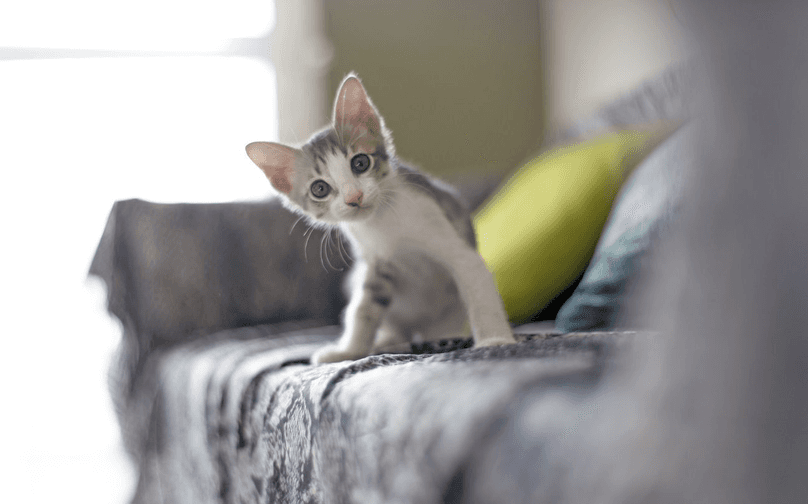
Bringing home a new kitten is exciting—but it can also be stressful. Kittens are naturally curious creatures and they’re well known for getting into places and things they shouldn’t. While visions of scratched-up furniture and broken objects might be at the forefront of most people’s concerns, it’s also vital that your kitten has a safe home environment where it can play and grow without being at risk. Kittens are creative and it can be hard to think of every potential hazard. That’s where following a new kitten checklist for kitten-proofing your home comes in handy.
Remember that every kitten is unique. The more time you spend with your new kitty, the more familiar you’ll become with its habits and preferences—and the easier it will be to proactively keep it safe. However, there are a few checklist items that every kitten owner should consider from the start:
- Plan to meet your kitten’s instinctive needs
- Define boundaries
- Secure harmful substances
- When in doubt, pick it up
- Be patient and stay alert
Plan Ahead to Meet Your Kitten’s Needs
The needs of a kitten go beyond access to food, water and a place to go to the bathroom. Like any other living creature, kittens are hardwired with instincts gained from centuries of evolution. It’s usually better to find creative ways to satisfy these instincts rather than trying to prevent them.
For example, scratching is a normal, instinctive cat behavior. Providing approved surfaces for scratching and climbing, like a tall, sturdy scratching post, is always a good idea, especially when your kitten is young.
It’s also important to keep other cat-typical personality traits and behaviors in mind. Kittens and cats are infamous heat-seekers. While curling up around a lamp base usually isn’t a problem, it can become dangerous if your kitten finds its way into a recently used dishwasher or dryer.
Along with getting in the habit of closing the doors for these appliances and checking them before every single use, providing your kitten with warm, safe cubbies and beds throughout your home can be a great way to circumvent this risk. The North Shore Animal League of America recommends using heating pads or self-warming blankets that are designed for pets and restricting unsupervised access to things such as fireplaces and space heaters.
Define Boundaries: Deciding Which Areas Are Off Limits
The next item on the new kitten checklist is to define boundaries for your kitten. Deciding early on where your kitten is and is not allowed to go in your home will help you when it comes to supervising the kitten and preventing any mishaps.
Keep doors to closets closed to avoid accidentally shutting the kitten inside, and restrict access to rooms with potentially harmful substances, such as garages and bathrooms. You may also want to consider moving any breakables to high, inaccessible shelves.
Another consideration that is commonly overlooked is furniture with opening mechanisms, such as sleeper sofas or reclining chairs. If you have these in your home, keep in mind that your kitten may find its way beneath them and this can be extremely dangerous. If you can’t block access, make sure you’re always aware of where your kitten is before opening or closing these pieces of furniture.
Secure Harmful Substances and Research House Plants for Toxicity
Because kittens are still learning about the world around them, they’re not always aware of things that pose a threat to their health and safety. That’s why it’s essential to factor in securing harmful substances throughout your home.
Cupboards containing medicines and cleaning supplies shouldalwaysbe inaccessible to pets of any age in order to avoid accidental poisoning.
If you’re a plant person, it’s also essential to research your house plants to make sure they’re not toxic to your new kitten. Kittens and cats love to chew on live vegetation, but common household plants like lilies and ficus trees can cause severe digestive problems if consumed by your kitty. This goes for temporary bouquets as well. A good rule of thumb before bringing in any new greenery: if you’re not sure, double-check and consider replacing toxic plants with harmless alternatives.
When in Doubt, Pick it Up
As a new kitten owner, you may be surprised at what your kitten can turn into a toy. Kittens love to play and they may be attracted to everything from sewing needles and hair ties to electronic cords and plastic bags.
While some kittens and cats are perfectly fine to play with some of these items, such as hair ties and the plastic rings you take off your milk jug, others have a habit of following through with their hunting instincts and consuming these items.
In the beginning, it’s best to err on the side of being overly conscientious. In order to avoid potential intestinal blockages and expensive emergency vet bills, pick up any non-food item that your kitten might be able to swallow.
Be Patient and Stay Alert
Most importantly, when following your new kitten checklist, remember to be patient and stay alert. Give your kitten time to adjust to its new home. Take the first few weeks to become familiar with its particular behaviors and habits. Use the checklist to provide for your kitten’s needs and take preventive measures to ensure their health.
No checklist is all-inclusive, and many kittens can be more innovative than many pet owners anticipate. Still, by being mindful of these items (and maintaining a good sense of humor), you’ll be able to provide a safe and happy home for your new kitten.
For more tips on how to kitten proof your home, watch this video from Jackson Galaxy, cat expert:
Editor’s Note: For health-related issues, please consult with your pet’s veterinarian first.